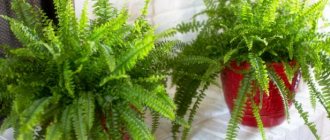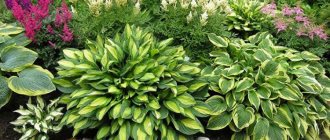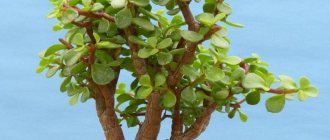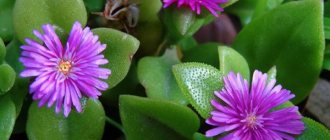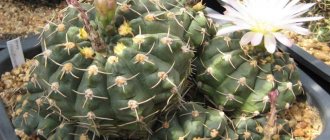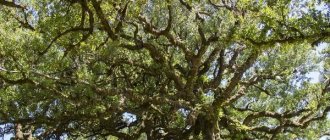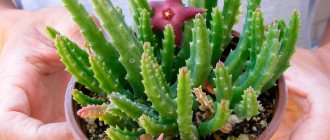Davallia is a beautiful indoor plant, perfect for propagation and care at home, greenhouses, and offices.
But there is one condition: constant heating is needed. The flower received its name in honor of the English botanist E. Davalla. The representative of the flora is attractive with its unusual shaggy, red-brown roots. They grow and begin to hang over the edges of the pots. This property and similarity evoke associations with hare feet and deer antlers.
Botanical description
Latin name: Davallia. An exotic representative of the genus of ferns. Fast-growing perennial, family Davalliaceae. The places of natural growth are mainly the tropics of Asia , but are found in Chinese and Japanese forests, in Polynesia, on the islands of Java, Fiji. The genus “Dawallia” is a group of approximately 35 species of epiphytic ferns that are often grown at home.
Almost all of these plants are distinguished by creeping rhizomes. They are covered with a thick layer of silvery, black-brown long hairs. Why do they resemble rabbit feet?
Root shoots up to 2 centimeters thick are located on the ground, some hang over the edges of the pot.
The fern has openwork triangular leaves, dissected into small plates . The color is light green, length - up to 40 centimeters, width - 35 centimeters, on high petioles. Davallia has 60 subtypes. These are ornamental plants that are grown not only in indoor flower beds, but also on the windowsill at home.
Kinds
Davallia Mariesa
A compact plant with thin rhizomes, no more than 22-26 cm in height. A cold-resistant plant that is suitable for unheated greenhouses and winter gardens. The rhizomes are covered with many brick-colored scales. The leaves are fluffy, pale green.
Photo of the subspecies Davallia Mariesa:
Dawallia canariasis
The most famous variety, popularly nicknamed “hare’s feet”, “squirrel’s feet”, “deer’s foot” because of the densely pubescent rhizomes.
As they grow, they begin to crawl out of the pot, hanging over the edges. It has triangular-shaped leaves that are colored in different shades of green.
Photo of the subspecies Davallia canariasis:
Dawallia quinquefolia
A small fern suitable for growing in closed soil. It has thick chocolate-colored rhizomes, covered with small dense hairs. The leaves are glossy, have a strong shine and a deep green color.
Photo of the subspecies Davallia five-leaved:
Dawallia dense
A perennial from Australia, used as a hanging or climbing plant. A very beautiful species with wide, triple-pinnate leaves. Over time, the rhizome becomes woody and covered with thin scales.
Photo of the subspecies Davallia dense:
Dawallia vesiculata
A guest from the tropics of Asia, most often lives in China and Japan. Suitable for growing in conditions of constant humidity. A low, compact fern with creeping rhizomes. The leaves are linear, three and four pinnate, colored in emerald tones.
Photo of the subspecies Davallia vesicularis:
You can learn more about common types of ferns here.
Varieties and photos
Below are photos and descriptions of dawllia varieties suitable for propagation and care at home.
Fijian
It differs from other species in the more intense color of the green parts and the shape of the leaf blade. The bush is tall, spreading, reaching a height of up to 1 meter. Leathery, 35 centimeter leaves are attached to thin, drooping shoots. This variety of fern looks good in hanging planters. Dawllia Fiji annually sheds its old leaves and new shoots grow in their place. The photo below shows the Fijian:
Canary
Davallia canariensis or Trichomanes is a subspecies of fern that was introduced from the Canary Islands. Other areas of growth are also known, these are the Pyrenees Peninsula, North Africa. The roots are not very long, up to 13 centimeters. The leaf together with the petiole has an equal length - 25-30 cm . The frond (leaf) has a patterned structure. It is feathery, with dissected, diamond-shaped segments. Spore-bearing capsules are located in the upper part of the plane.
This indoor plant is loved by gardeners because it does not experience discomfort from being kept in a cool room and does not suffer from the lack of high humidity.
Davallia canariasis has oblong, dagger-shaped leaves. Their edges are dissected in the form of teeth, on rachises (stalks), pressed close to each other. The thickened, straight rhizome is strewn with silvery scales. This type of indoor fern has light green leaves with pinnately dissected triangular segments. Their length is 15-20 centimeters longer than that of the common fern. You can see what the Canary variety looks like in the photo below:
Mariesa
The homeland of this species of fern is Japanese forests. The dimensions of Dawllia Moriesa reach up to 25 centimeters . The leaf blades, like those of other representatives of ferns, are trapezoidal in shape, with a pinnate excision. The leaflets are pubescent, shiny, light emerald green. The root shoots of this species are thin, scaly, and brick-colored. As they grow, they almost always intertwine, creating beautiful complex patterns. In the photo below is the Mariesa variety:
What kind of plant is this?
In nature, dalia grows in the tropical zone: in the Canary Islands, Japan and China. In temperate climates and northern regions, it is suitable for growing in greenhouses and warm rooms.
It has triangular feathery leaves of light green color. The rhizomes often “crawl out” of the pot, which is why they gave it the popular name - hare's foot. There are about forty species in the genus.
Interesting fact. In nature, dalia can grow up to 1 m in height and up to 1.8 m in diameter. When grown indoors, the size of the green pet is much more modest - 20-45 cm.
Davalia looks great in wall pots and stands. In addition, this plant is perfect for creating “living” design compositions; it will lift your spirits and please the eye.
Care
If the plant was purchased in a store or brought from another home, it is necessary to inspect it. Often, you can find harmful insects or signs of disease in a new indoor flower. It is worth immediately giving the greenery a shower with warm water and generously shedding the soil. Then, you need to treat it for preventive purposes against pests and diseases.
You can’t place davalia with other house plants. She needs to be quarantined. Place for two weeks in a separate place, away from other plants. After 14 days, the fern can be transplanted into a looser pot.
Lighting
All types of dawllia need bright, diffused light. Direct sunlight harms the delicate leaves of the fern . For comfortable growing, windows facing west and east are suitable. If there is such a need, you can place the flower in a dark place, but not for a long period. Otherwise, the plant stops developing.
Temperature
Davallia is dense and bubbly and can withstand temperatures of 17-25°C.
Moreover, it is advisable to adhere to these values all year round. Low temperatures cause slower growth and further death. The Canary Dawllia, in winter, can tolerate a temperature drop of 14 to 17 degrees. A kind of inhibition during the growing season makes it easier for the plant to overwinter.
Humidity and watering
For dawllia, provide abundant watering. Use warm, soft, settled water. This moistening should be done when the top layer of soil dries out. In winter it is worth reducing the amount of watering . However, the fern is quite sensitive to overdrying of the substrate; this should not be allowed.
Watering should preferably be done using a watering can with a long spout. This is necessary so that moisture does not settle on the overgrown roots hanging from all sides. It is good to use bottom watering.
All varieties of dawllia ferns have difficulty withstanding dry air. For successful cultivation, it is necessary to increase the humidity level in the room. Once a day, irrigate the leaves with a spray bottle of settled water. It is also good to place containers with indoor plants on flat trays with wet sand and peat. The Canarian dawllia is more resistant to dry air.
Top dressing
They add useful substances under the roots, from spring to early autumn - April-September.
To do this, dilute fertilizer for indoor ferns according to the diagram attached to the substance. Water once every 30 days. With the onset of autumn cold weather and winter, davallia does not need to be fed. Otherwise, there is a risk of root rotting or serious diseases.
Transfer
It is advisable to replant ferns during the growing season. This should be done only when the rhizomes are growing strongly. It is worth taking a shallow pot for this purpose, because the root system of the plant is on the surface. It is better not to replant in plastic containers, but to buy flower pots with holes. This way the roots will be enriched with oxygen - “breathe”.
A fern grown on a tree snag looks beautiful . An epiphyte (a plant living on another plant) is transplanted onto the surface of the bark. Lay coconut fiber or sphagnum moss on the driftwood or bottom of the pot. It is good to fix the seedling on the wood. The roots, as they grow, tightly wrap around it on all sides. But this method does not allow you to fully moisturize the dallia.
Priming
It is better to choose a substrate with weak acidity for planting ferns. You can use peat, leaf humus, and river sand. Mix in equal parts. Buy containers with a wide top. Be sure to put a drainage layer of expanded clay and broken clay shards on the bottom. It's good when the substrate contains organic matter. For example, you can make the following mixture:
- turf - 0.5 kg;
- small bunch of moss;
- river sand - 0.5 kg;
- peat - 1 kg;
- leaf humus - 1 kg;
- charcoal - 0.5 parts.
Fern transplantation is done once every 2-3 years, in the spring.
How to help a plant adapt to an apartment?
In order for dalia to take root well on the new pestle, several steps should be followed after acquisition.
- After purchasing, be sure to check the food for diseases and pests.
- Place the plant in a shaded room and gradually acclimate it to a constant level of light over several days. The fact is that dalia easily tolerates shade, but in high light conditions the fern leaves grow thicker
- Spray the foliage with warm water from a spray bottle.
- Moisten the soil in the pot thoroughly.
- In the first two weeks, you should keep dalia away from other plants, setting up a kind of quarantine. During the same period, give your green pet preventative treatment against insects.
Important! Before purchasing dali, you should keep in mind that the seeds of this tropical fern can cause allergies. Especially if among family members there are people with chronic respiratory problems.
Reproduction
Davallia can be propagated in two ways: by dividing the roots and by spores. How does this happen?
Disputes
Sori (spore capsules) are attached to the underside of the frond.
- When it is time to be ready to reproduce, they acquire a dark color. You need to scrape off the spores and put them in a dark place to dry for 2 days.
- Prepare a container with low sides, fill it with peat soil and moisten it. It is advisable to warm the soil with boiled water or fry it in the oven. This will increase the percentage of spore germination.
- Spread planting material evenly onto a damp surface. Cover the container with cling film and place on the windowsill for germination. The temperature in the room should not fall below 13 degrees. Shoots appear in approximately 27-30 days. Young shoots should be sprayed with warm water from a spray bottle.
- Do not remove the film, ventilate the sprouts once a day for 10 minutes. Dense plantings must be planted using tweezers, which must be sterilized in advance.
Air baths should be gradually increased in time; by the end of the month, the film can be removed.
Dividing the root
The most popular and simplest propagation method is dividing the rhizome. The procedure is carried out in mid-April. The roots are cut into pieces so that each has 1-2 leaves . The segment can be laid out on the ground surface, pinned or attached to a support and placed in a horizontal position. The earth must be constantly moistened. After 2 months, the cut part will produce roots. Make sure that the plantings are well lit and do not dry out.
Growing Davallia from spores
Ferns can reproduce by spores. This method takes quite a lot of time.
Spores form on the foliage of mature plants. They need to be shaken into a paper envelope and placed in a dry, dark place. Next, they need to be sown in a shallow container filled with loose sterilized soil and covered with glass. They should be exposed to diffused light.
Spores germinate at room temperature. This usually takes from 2 to 6 weeks. Any growths that appear should be carefully sprayed and continue to be stored under glass. After about 2 months, when young bushes appear, the peat needs to be divided into parts and planted. It is better to place them in a closed aquarium to tame them to dryness.
Diseases and pests
Beginning flower growers often make mistakes in care, which can cause pests to infest the plant or cause diseases. Excessive soil moisture and low room temperature lead to the development of gray rot and other fungal diseases. When humidity is low, spider mite attacks become more active. Insufficient care and, as a result, a weak plant is susceptible to invasion by harmful insects:
- Whiteflies.
- Spider mite.
- Mealybugs.
- Nematodes.
- Thrips.
- Scale insects.
- Aphids.
Lesions on dawllia are immediately visible. Fern branches turn yellow, wither and dry out. Remove such fronds immediately. If parasites are noticed, it is better to collect them by hand. When this is ineffective, the insects are washed off with a shower, after rubbing the leaves with green or laundry soap. When the damage becomes alarming, insecticides have to be used .
It is good to treat ferns with Actellik, Aktara, and Karbofos. Strictly adhere to the dosage! Remove ticks with acaricide.
It will take longer to fight nematodes; in some cases, there is nothing left to do but destroy the plant. It is advisable not to lead to such an outcome.
All insecticides contain toxic substances; contact of pets with the plant must be prevented. It is advisable to put the fern in another room or on a high shelf.
Main difficulties
Pests are very fond of beautiful and delicate fern fronds. In addition to a wide range of the most common indoor pests, davallia also has a personal enemy - the fern aphid, which, unlike ordinary aphids, can be black in color. At the first signs of the presence of insects, the plant must be treated: first with folk remedies (soap, tobacco solution), and, if this does not help, then apply insecticides.
Diseases also do not bypass davallia. The most common is root rotting from cold air or water and drafts.
Photo gallery
alla_tomashchuk
ilove_flowers.36
pro_rasteniya.gel
bert_flowers
katrin_shedevr
ilove_flowers.36
Epiphyte requirements for conditions of detention
Caring for the dawllia fern at home, first of all, means creating comfortable conditions for it. Lighting should be good, but diffused. On southern windows, the leaves will dry out and become covered with brown spots from sunburn. On the north side, davallia will be able to live, but it will grow more slowly and will not be as lush.
Davallia has a high requirement for air humidity, but at the same time tolerates high temperatures well. If the temperature in the room is even up to 40°, the epiphyte will not be afraid. But only on condition that the air humidity is at least 70%. On average, summer comfortable values are 22°C. But the fern prefers to overwinter in slightly cool conditions, but not below 15° C. In colder conditions, it will shed its leaves.
It is better to choose a wide flowerpot for davallia, because its underground roots are superficial. Plastic containers should be left for other colors, giving preference to natural materials. Despite the love for moisture, drainage and the presence of holes in the vessel are mandatory requirements.
Indoor dallalia fern needs breathable, light and slightly acidic soil.
You can purchase a special substrate for ferns or prepare it at home by mixing:
- leaf and turf soil;
- sphagnum;
- peat;
- sand;
- some charcoal.
The epiphytic abilities of davallia make it possible to completely abandon the soil as such. You can grow a fern without soil or a pot by planting it on a woody base. It could be a snag or a small stump with a hollow. Sphagnum or coconut fiber should be placed under the bush itself and secured with rope. You can also cover the surface of the driftwood directly around the plant with moss.

